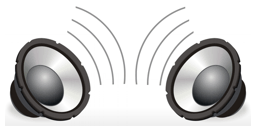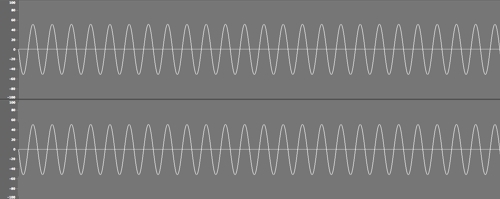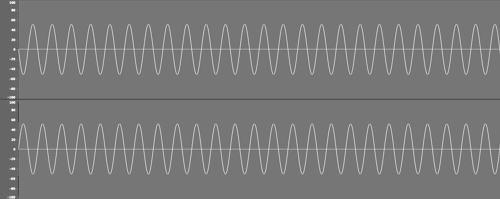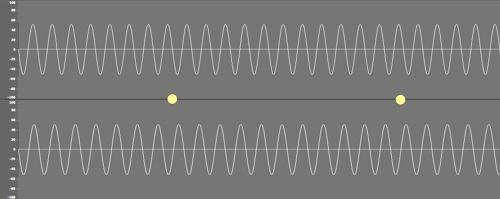For Lovers of Meditation
What are Binaural Frequencies & How are they Created?
Binaural frequencies are created by taking advantage of an acoustic effect known as "wave interference". The following article outlines how wave interference occurs, and how it is used to create binaural beats that are used for brainwave entrainment.
Warning! Technical Content!
 |
Things can get a bit technical in this article, but we've done our best to keep the information as down to earth as possible. Take your time and remember, you don't have to understand the science of binaural beats to enjoy the benfits they bring! |
Understanding Wave Interference

Sound waves like the ones shown further down this page are simply a representation of changes in sound pressure levels that take place over time. Rapid fluctuations in sound pressure levels are detected by our sensitive eardrums and then transmitted to the brain, which then interprets these fluctuations as sound.
A speaker cone creates these rapid fluctuations in sound pressure levels by moving backwards and forwards at a specific frequency. The speed of movement of the speaker is directly proportional to the frequency (pitch) of the sound.
Air pressure waves created by two separate speakers will interfere with each other in one of three ways:
1. They may add to each other to create a louder sound (constructive interference).
2. They may cancel each other out, creating silence (destructive interference), or,
3. They may interfere with each other in more complex ways, combining to create new sounds that contain harmonics.
The following diagrams illustrate how wave interference occurs and how this effect can be used to create binaural frequencies.
Constructive Interference
Figure 1 shows two sine waves (one of the simplest forms of sound waves) that are perfectly “in phase”. The two waves represent the left and right channels of a stereo signal, and we say that they are in phase because the peaks and troughs of the two waves are perfectly aligned.

Figure 1
When played, the in-phase sine waves add to each other, creating a more powerful sound wave (figure 2). The frequency of the resulting sound is the same as the original stereo sine wave sound, only louder.

Figure 2
Destructive Interference
Figure 3 shows two sine waves that are perfectly “out of phase”. Both sine waves have the same frequency, but you’ll notice that the peaks and troughs of the lower waveform are a perfect inversion of the upper waveform.

Figure 3
When played, the two signals cancel each other out, resulting in silence (figure 4). This is known as phase cancellation.

Figure 4
In the real world this effect is extremely uncommon, mainly because the natural sounds we hear around us are more complex than simple sine waves. However it is interesting to note that music producers and audio engineers do have to pay attention to this effect when they go through the process of producing music for a CD and are always mindful of phase cancellation problems that can sneak into a recording and harm the integrity of the overall sound.
Creating Binaural Frequencies
Figure 5 shows two sine waves that have slightly different frequencies. Starting from the left side of the image, the peaks and troughs of both sine waves are in phase, but because the lower waveform is of a slightly different frequency, it moves in and out of phase with the upper sine wave in a cyclical fashion. At the points I have marked with a yellow dot, the two sine waves are completely out of phase.

Figure 5
The interference pattern oscillates between constructive wave interference and destructive wave interference, resulting in a sound that is louder when the two sine waves are in phase, and silent when they are completely out of phase.

Figure 6
The frequency of the binaural tone is equal to the difference between the frequencies of the two sine waves. For example If a 300 Hz sine wave interferes with a 305 Hz sine wave, the resulting binaural frequency will be 5 Hz.
The Sound of a Binaural Frequency
If you were to play a binaural sound (like that shown in figure 5) on a stereo and listen to it without headphones, you would hear the binaural frequency quite clearly as an audible pulsing sound. This is because the sound that is emitted from the left speaker travels through the air and quite literally, interferes with the sound travelling out of the right speaker.
But if you listen to such a recording with headphones (as is the case when listening to a binaural meditation), then the sound travels directly into your ear canals. What this means is that left and right channels of the stereo sound are completely separated and are unable to interfere with each other. As a result, rather than hearing a very obvious beating sound, you will hear a tone that is almost totally constant, with perhaps a very subtle pulsing quality to it. The binaural beating may not be particularly audible, but your brain does interpret the difference between the two frequencies, leading to the brainwave-synchronization process known as "entrainment" or the "frequency following response".
To learn more about the major categories of brainwave activity and the binaural frequencies that activate them, please follow these links:
Beta brain waves - 12 Hz to 30 Hz
Alpha brain waves - 8 Hz to 12 Hz
Theta brain waves - 4 Hz to 7 Hz
Delta brain waves - 0.1 Hz to 4 Hz
More information on wave interference can also be found here.
This article is copyright protected, however you may republish it online or in print media provided that you include the following credit, including the active link:
Article by Christopher Lloyd Clarke from www.The-Guided-Meditation-Site.com.


Download Binaural Meditation MP3's
Super relaxing sleep music with binaural beats
Got questions about binaural beats and binaural meditation?
Listen to relaxing meditation music
Download Positive Affirmations With Binaural Beats